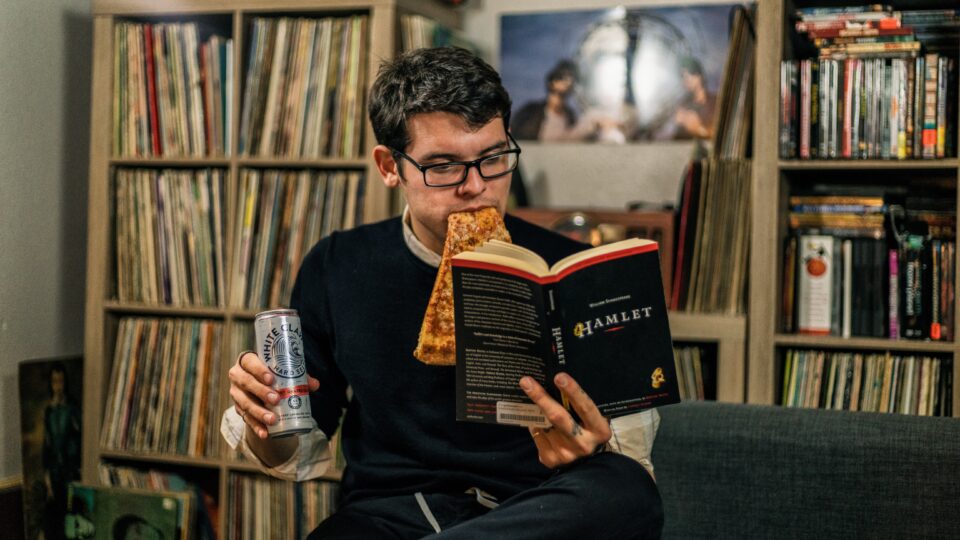
During the Renaissance the concept of drama was to change completely. Through their multi-faceted heroes and heroines, the dramatists of the age, led by Christopher Marlow and slightly later by William Shakespeare, began to explore the many sides of human nature. Shakespeare’s literary achievement is unprecedented and has arguably never been equalled in its originally or range of concerns. Shakespeare seems paradoxically both the greatest dramatist of the Renaissance and even the greatest dramatist of the modern period. There are two important elements that make him different from other writers: from one hand he explores all aspects of human life, on the other hand he’s the first to consider the “Great problem of existence” without any influence of the past, independently of pre-existing models of thought. For this reason, we can say that characters of Shakespeare’s plays are free artists of themselves.
In this view, one of the greatest examples of Shakespeare’s attitude, is surely “Hamlet”. Generally speaking Hamlet is a revenge story. However it’s much more than a tragedy of revenge: among themes explored in the play there are the meaning of action, power, death, the nature of human beings and so on … A recurrent motif is the idea that corruption can be hidden under the false appearance of exterior. In a sense, the relationship between appearance and reality is exemplified in the “play within the play”. To clarify, inside the main play there’s another play: the actors of Hamlet become the audience of “The murder of Gonzago”. Anyway, the most important thing is that the figure of Hamlet can be seen as philosopher of himself, so he becomes one of the first truly modern characters in literature. He’s isolated, cut off both from society and from any kind of religions or moral certainty. As a result, Shakespeare invents a character who is free to decide for himself. Even though the consequences of his actions are beyond his control.
A recurrent motif is the idea that corruption can be hidden under the false appearance of exterior.
Shakespeare’s most famous monologue takes place at the beginning of Act III, when Hamlet is already suspected to be mad (the cause of this, however, is unknown). Polonius belives that Hamlet’s madness is the result of his unhappy love for Ophelia. Polonius and King Claudius hide themselves to see at Hamlet’s behaviour.
The crucial question of this passage is the choice between action and inaction. Beyond Hamlet’s incapacity to carry out the revenge on his uncle, two philosophical positions are expressed:
- the Stoic attitude of enduring life’s evils at all costs;
- the Suicide, the belief that, if necessary, man may end life by killing himself.
The best-known lines in English literature, the first six words of the monologue establish a balance. There is a direct opposition – to be, or not to be. Hamlet is thinking about life and death and he is pondering a state of being against a state of not being – being alive or being dead. The choice is between a patient forbearance of adverse fortune and, on the other hand, an active opposition (1-5 l). The question of how he should act, therefore, becomes a question only he can answer. Hamlet shows profound pessimism: after some general statements on death and life (5-14 l) in which he lists characteristic human sufferings (14 – 22 l), he examines the thought of life after death (22-33 l) . This is something which nobody really knows and everybody fears. According to Hamlet, the fear of death is what lets us bearing human sufferings and not committing suicide. The incapacity of action is quite clear in the last lines.
The choice is between a patient forbearance of adverse fortune and, on the other hand, an active opposition (1-5 l).
In this view, life is purely a lack of power: the being is at the mercy of the blows of outrageous fortune. The only way of opposing them is by committing suicide. This brings us to the conclusion that death is empowering: killing oneself is a way of taking actions, of taking up arms, of opposing and of defeating the slings of a sea of troubles. Contrary to the Christian view of life, living is a passive state, while dying is an active state. Anyway, the whole preposition is circular and hopeless because Hamlet does not really have the power of action in life. As a matter of fact, although Hamlet attempts to pose such a question in a rational and logical way he is still left without an answer.
This choice is the story of mankind, our beliefs, our struggles, our traditions and our inspirations. The choice is the story of us. The “Great problem of existence”, life is so many things to so many people. What do you think life is ? Hamlet wants to be free of injustices , wants to escape sufferings, wants a better world. With this intensity of tone, there is always the impression that Shakespeare is trying to convey an idea which is larger and bigger than what words permit him to express. In a sense, under his words, it is possible to find the constant research for absolute. In this reflection on the transience of human condition, Shakespeare’s poetry seems a way of sensory and intellectual reveries in which Hamlet tries to lose himself. Beyond the moral purpose, this monologue celebrates the qualities of human mind, its ability to create a world maybe of pure imagination, maybe not, but surely outside language’s possibilities. It is fascinating to think Hamlet has reached “The human apocalypse” ; it is not about death, it is about enlightenment, Hamlet has reached a state of mind and heart that helps him to see the truth; Hamlet has lifted the veil, Hamlet unconsciously is now free.
Shakespeare seems paradoxically both the greatest dramatist of the Renaissance and even the greatest dramatist of the modern period.
If you liked the article let’s give me a feedback, write me, share it. Enjoy!
